Dissertation on the Scope and Impact of the 1951 Refugee Convention
VerifiedAdded on 2022/09/27
|72
|20032
|91
Thesis and Dissertation
AI Summary
This dissertation delves into the scope and impact of the 1951 Refugee Convention, a crucial legal instrument governing refugee protection. It begins with an overview of the Convention, its key principles like the definition of a refugee and non-refoulement, and its historical context. The study then examines the Convention's role in providing protection to refugees and asylum seekers, exploring the rights and duties of both refugees and signatory states. It analyzes the aspects of the refugee definition that have prompted calls for reform, and addresses challenges such as poor infrastructure in receiving countries, discrepancies between international and regional approaches to refugee care, and the issue of gender-based violence. The dissertation also investigates the evolving global attitudes towards refugee protection, including the impact of factors like maximum influx, cross-border displacement, and climate change. It concludes by assessing the need for reform in light of contemporary challenges and the potential role of the UNHCR in providing adequate refugee protection.
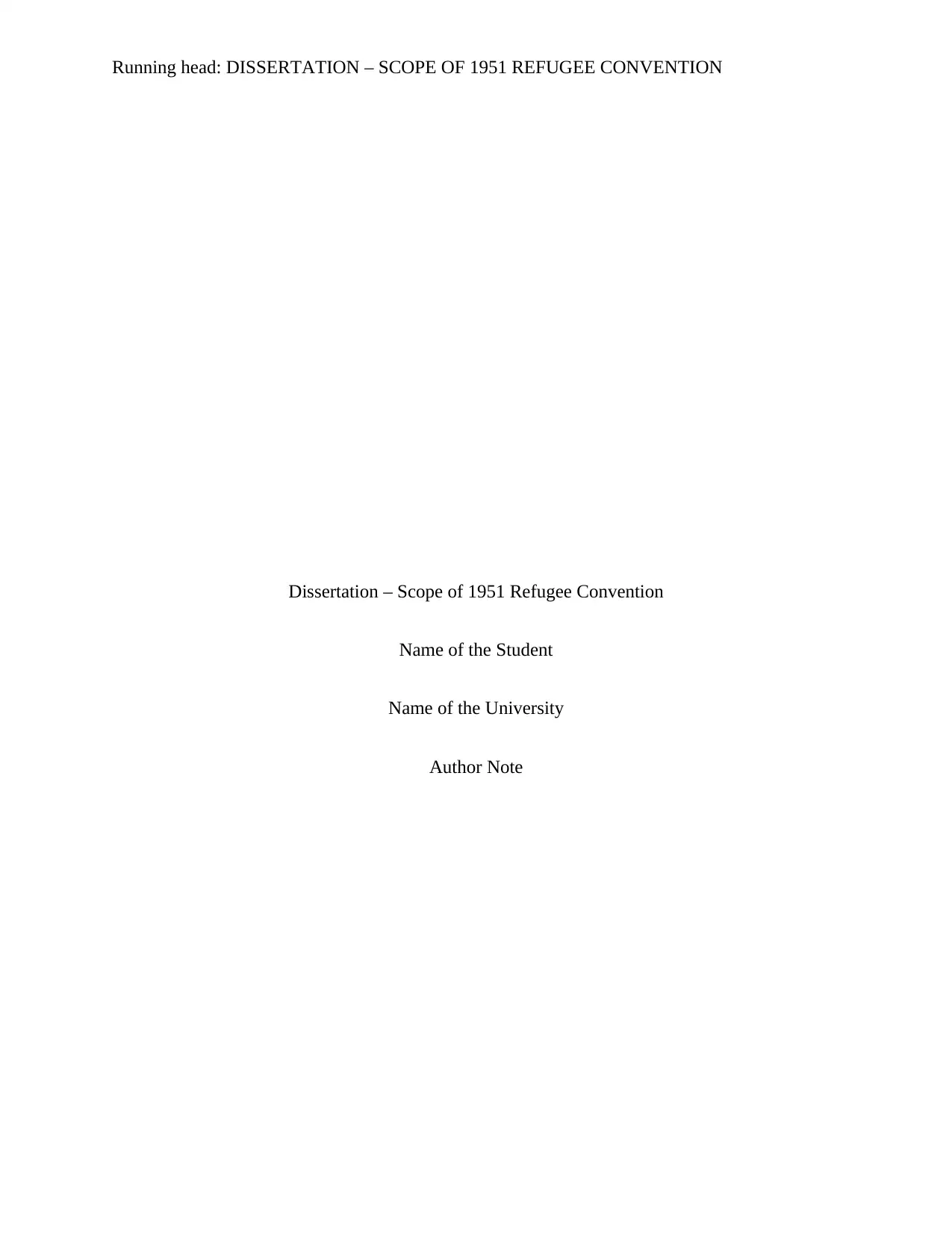
Running head: DISSERTATION – SCOPE OF 1951 REFUGEE CONVENTION
Dissertation – Scope of 1951 Refugee Convention
Name of the Student
Name of the University
Author Note
Dissertation – Scope of 1951 Refugee Convention
Name of the Student
Name of the University
Author Note
Paraphrase This Document
Need a fresh take? Get an instant paraphrase of this document with our AI Paraphraser
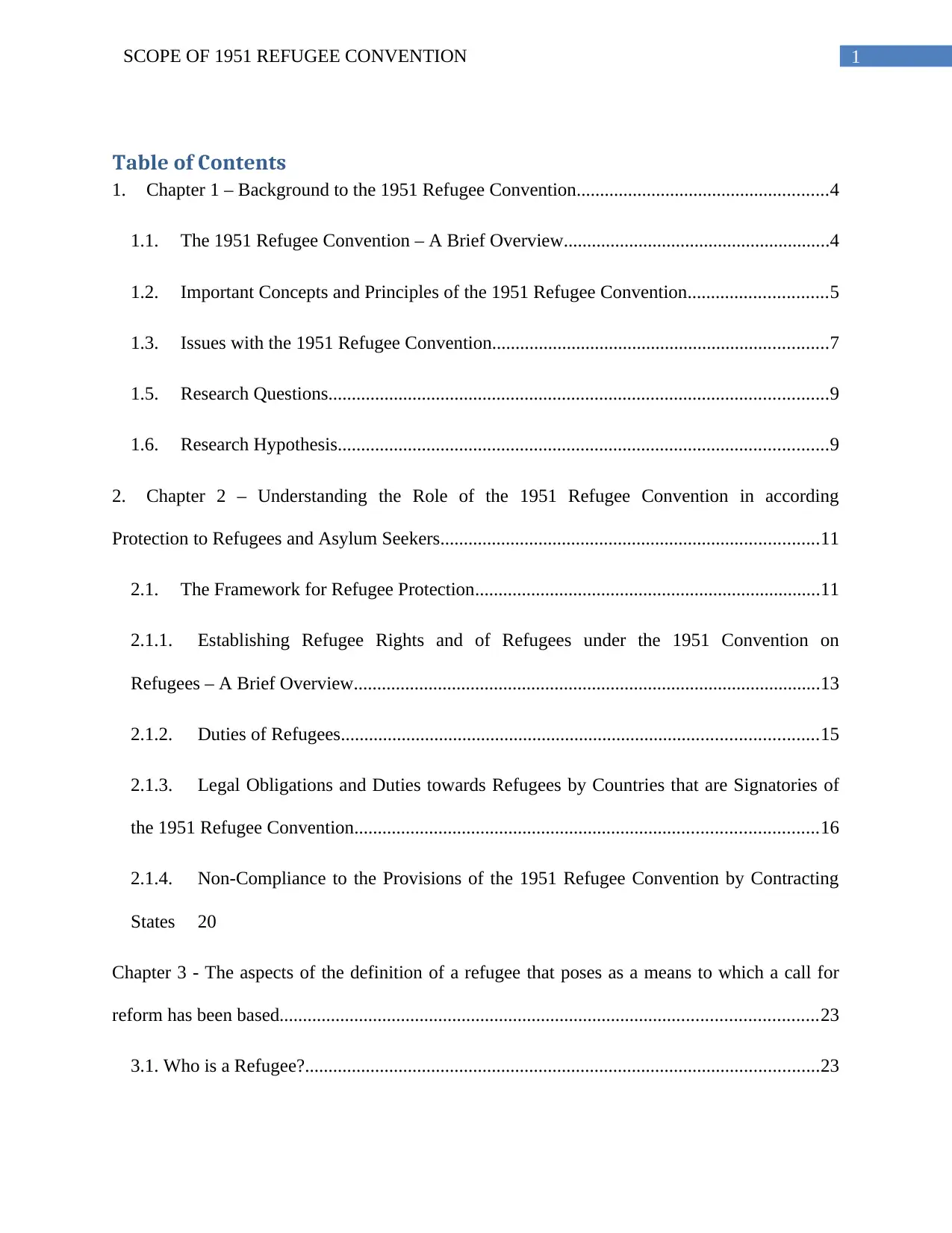
1SCOPE OF 1951 REFUGEE CONVENTION
Table of Contents
1. Chapter 1 – Background to the 1951 Refugee Convention......................................................4
1.1. The 1951 Refugee Convention – A Brief Overview.........................................................4
1.2. Important Concepts and Principles of the 1951 Refugee Convention..............................5
1.3. Issues with the 1951 Refugee Convention........................................................................7
1.5. Research Questions...........................................................................................................9
1.6. Research Hypothesis.........................................................................................................9
2. Chapter 2 – Understanding the Role of the 1951 Refugee Convention in according
Protection to Refugees and Asylum Seekers.................................................................................11
2.1. The Framework for Refugee Protection..........................................................................11
2.1.1. Establishing Refugee Rights and of Refugees under the 1951 Convention on
Refugees – A Brief Overview....................................................................................................13
2.1.2. Duties of Refugees......................................................................................................15
2.1.3. Legal Obligations and Duties towards Refugees by Countries that are Signatories of
the 1951 Refugee Convention...................................................................................................16
2.1.4. Non-Compliance to the Provisions of the 1951 Refugee Convention by Contracting
States 20
Chapter 3 - The aspects of the definition of a refugee that poses as a means to which a call for
reform has been based...................................................................................................................23
3.1. Who is a Refugee?..............................................................................................................23
Table of Contents
1. Chapter 1 – Background to the 1951 Refugee Convention......................................................4
1.1. The 1951 Refugee Convention – A Brief Overview.........................................................4
1.2. Important Concepts and Principles of the 1951 Refugee Convention..............................5
1.3. Issues with the 1951 Refugee Convention........................................................................7
1.5. Research Questions...........................................................................................................9
1.6. Research Hypothesis.........................................................................................................9
2. Chapter 2 – Understanding the Role of the 1951 Refugee Convention in according
Protection to Refugees and Asylum Seekers.................................................................................11
2.1. The Framework for Refugee Protection..........................................................................11
2.1.1. Establishing Refugee Rights and of Refugees under the 1951 Convention on
Refugees – A Brief Overview....................................................................................................13
2.1.2. Duties of Refugees......................................................................................................15
2.1.3. Legal Obligations and Duties towards Refugees by Countries that are Signatories of
the 1951 Refugee Convention...................................................................................................16
2.1.4. Non-Compliance to the Provisions of the 1951 Refugee Convention by Contracting
States 20
Chapter 3 - The aspects of the definition of a refugee that poses as a means to which a call for
reform has been based...................................................................................................................23
3.1. Who is a Refugee?..............................................................................................................23
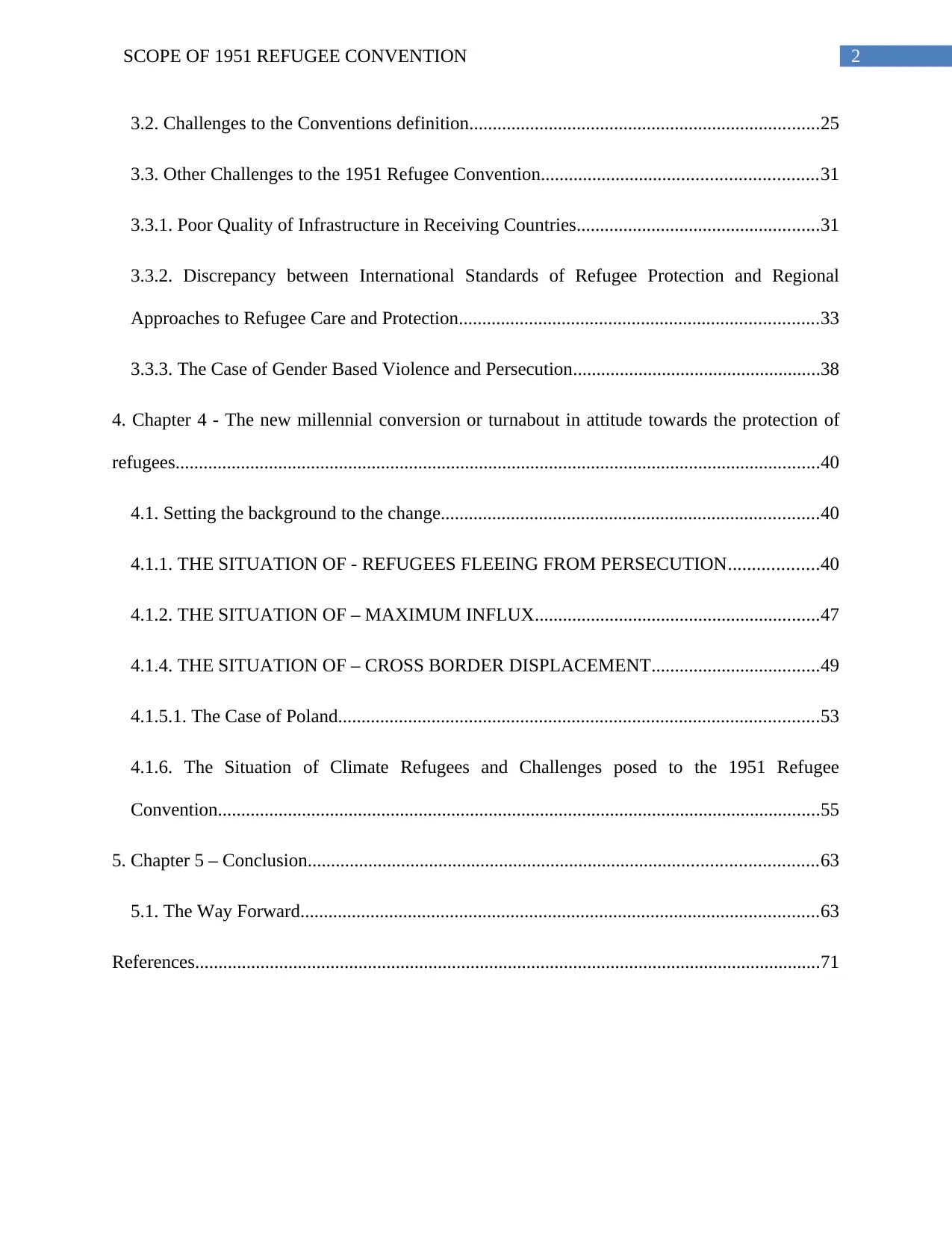
2SCOPE OF 1951 REFUGEE CONVENTION
3.2. Challenges to the Conventions definition...........................................................................25
3.3. Other Challenges to the 1951 Refugee Convention...........................................................31
3.3.1. Poor Quality of Infrastructure in Receiving Countries....................................................31
3.3.2. Discrepancy between International Standards of Refugee Protection and Regional
Approaches to Refugee Care and Protection.............................................................................33
3.3.3. The Case of Gender Based Violence and Persecution.....................................................38
4. Chapter 4 - The new millennial conversion or turnabout in attitude towards the protection of
refugees..........................................................................................................................................40
4.1. Setting the background to the change.................................................................................40
4.1.1. THE SITUATION OF - REFUGEES FLEEING FROM PERSECUTION...................40
4.1.2. THE SITUATION OF – MAXIMUM INFLUX.............................................................47
4.1.4. THE SITUATION OF – CROSS BORDER DISPLACEMENT....................................49
4.1.5.1. The Case of Poland.......................................................................................................53
4.1.6. The Situation of Climate Refugees and Challenges posed to the 1951 Refugee
Convention.................................................................................................................................55
5. Chapter 5 – Conclusion.............................................................................................................63
5.1. The Way Forward...............................................................................................................63
References......................................................................................................................................71
3.2. Challenges to the Conventions definition...........................................................................25
3.3. Other Challenges to the 1951 Refugee Convention...........................................................31
3.3.1. Poor Quality of Infrastructure in Receiving Countries....................................................31
3.3.2. Discrepancy between International Standards of Refugee Protection and Regional
Approaches to Refugee Care and Protection.............................................................................33
3.3.3. The Case of Gender Based Violence and Persecution.....................................................38
4. Chapter 4 - The new millennial conversion or turnabout in attitude towards the protection of
refugees..........................................................................................................................................40
4.1. Setting the background to the change.................................................................................40
4.1.1. THE SITUATION OF - REFUGEES FLEEING FROM PERSECUTION...................40
4.1.2. THE SITUATION OF – MAXIMUM INFLUX.............................................................47
4.1.4. THE SITUATION OF – CROSS BORDER DISPLACEMENT....................................49
4.1.5.1. The Case of Poland.......................................................................................................53
4.1.6. The Situation of Climate Refugees and Challenges posed to the 1951 Refugee
Convention.................................................................................................................................55
5. Chapter 5 – Conclusion.............................................................................................................63
5.1. The Way Forward...............................................................................................................63
References......................................................................................................................................71
⊘ This is a preview!⊘
Do you want full access?
Subscribe today to unlock all pages.

Trusted by 1+ million students worldwide
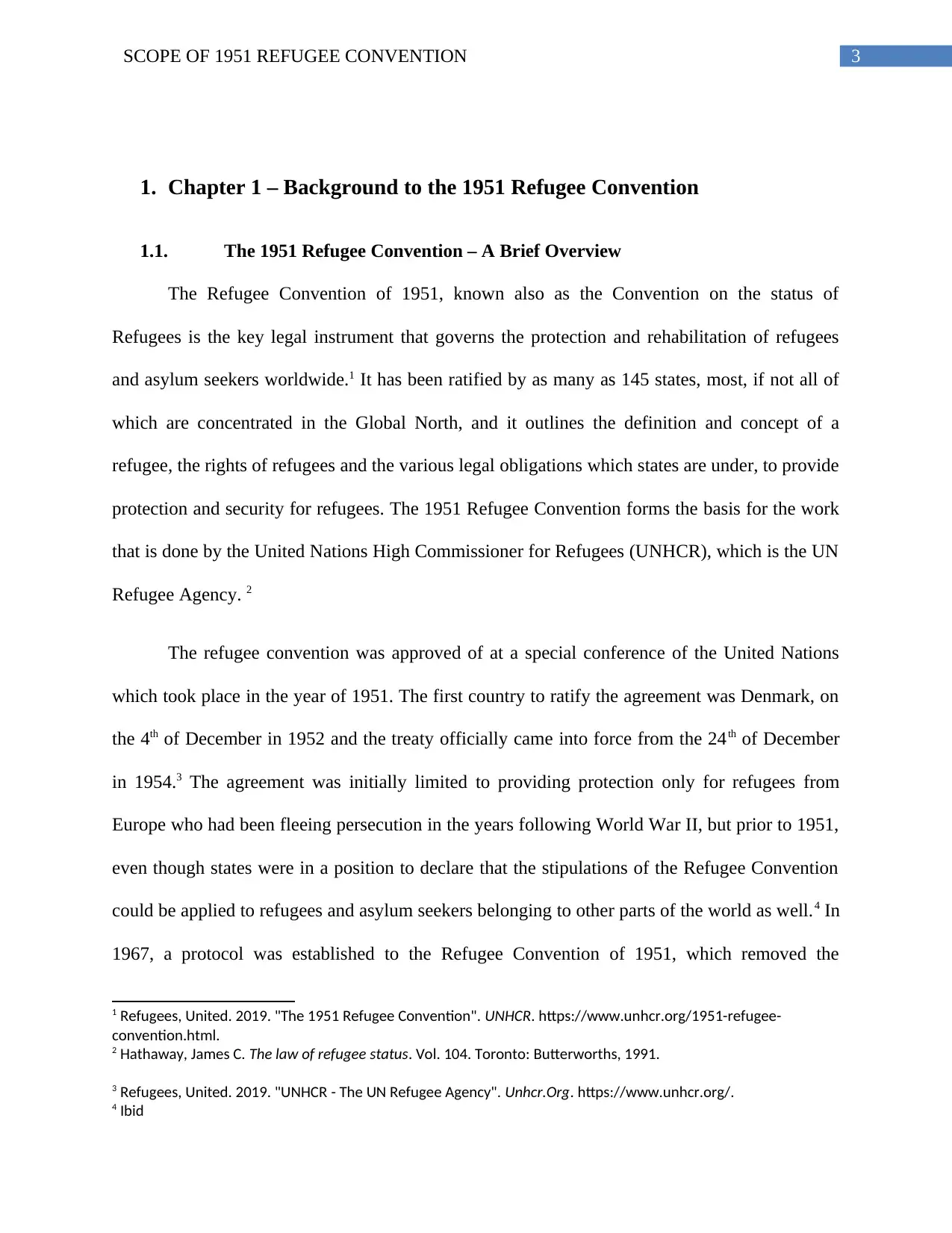
3SCOPE OF 1951 REFUGEE CONVENTION
1. Chapter 1 – Background to the 1951 Refugee Convention
1.1. The 1951 Refugee Convention – A Brief Overview
The Refugee Convention of 1951, known also as the Convention on the status of
Refugees is the key legal instrument that governs the protection and rehabilitation of refugees
and asylum seekers worldwide.1 It has been ratified by as many as 145 states, most, if not all of
which are concentrated in the Global North, and it outlines the definition and concept of a
refugee, the rights of refugees and the various legal obligations which states are under, to provide
protection and security for refugees. The 1951 Refugee Convention forms the basis for the work
that is done by the United Nations High Commissioner for Refugees (UNHCR), which is the UN
Refugee Agency. 2
The refugee convention was approved of at a special conference of the United Nations
which took place in the year of 1951. The first country to ratify the agreement was Denmark, on
the 4th of December in 1952 and the treaty officially came into force from the 24th of December
in 1954.3 The agreement was initially limited to providing protection only for refugees from
Europe who had been fleeing persecution in the years following World War II, but prior to 1951,
even though states were in a position to declare that the stipulations of the Refugee Convention
could be applied to refugees and asylum seekers belonging to other parts of the world as well.4 In
1967, a protocol was established to the Refugee Convention of 1951, which removed the
1 Refugees, United. 2019. "The 1951 Refugee Convention". UNHCR. https://www.unhcr.org/1951-refugee-
convention.html.
2 Hathaway, James C. The law of refugee status. Vol. 104. Toronto: Butterworths, 1991.
3 Refugees, United. 2019. "UNHCR - The UN Refugee Agency". Unhcr.Org. https://www.unhcr.org/.
4 Ibid
1. Chapter 1 – Background to the 1951 Refugee Convention
1.1. The 1951 Refugee Convention – A Brief Overview
The Refugee Convention of 1951, known also as the Convention on the status of
Refugees is the key legal instrument that governs the protection and rehabilitation of refugees
and asylum seekers worldwide.1 It has been ratified by as many as 145 states, most, if not all of
which are concentrated in the Global North, and it outlines the definition and concept of a
refugee, the rights of refugees and the various legal obligations which states are under, to provide
protection and security for refugees. The 1951 Refugee Convention forms the basis for the work
that is done by the United Nations High Commissioner for Refugees (UNHCR), which is the UN
Refugee Agency. 2
The refugee convention was approved of at a special conference of the United Nations
which took place in the year of 1951. The first country to ratify the agreement was Denmark, on
the 4th of December in 1952 and the treaty officially came into force from the 24th of December
in 1954.3 The agreement was initially limited to providing protection only for refugees from
Europe who had been fleeing persecution in the years following World War II, but prior to 1951,
even though states were in a position to declare that the stipulations of the Refugee Convention
could be applied to refugees and asylum seekers belonging to other parts of the world as well.4 In
1967, a protocol was established to the Refugee Convention of 1951, which removed the
1 Refugees, United. 2019. "The 1951 Refugee Convention". UNHCR. https://www.unhcr.org/1951-refugee-
convention.html.
2 Hathaway, James C. The law of refugee status. Vol. 104. Toronto: Butterworths, 1991.
3 Refugees, United. 2019. "UNHCR - The UN Refugee Agency". Unhcr.Org. https://www.unhcr.org/.
4 Ibid
Paraphrase This Document
Need a fresh take? Get an instant paraphrase of this document with our AI Paraphraser
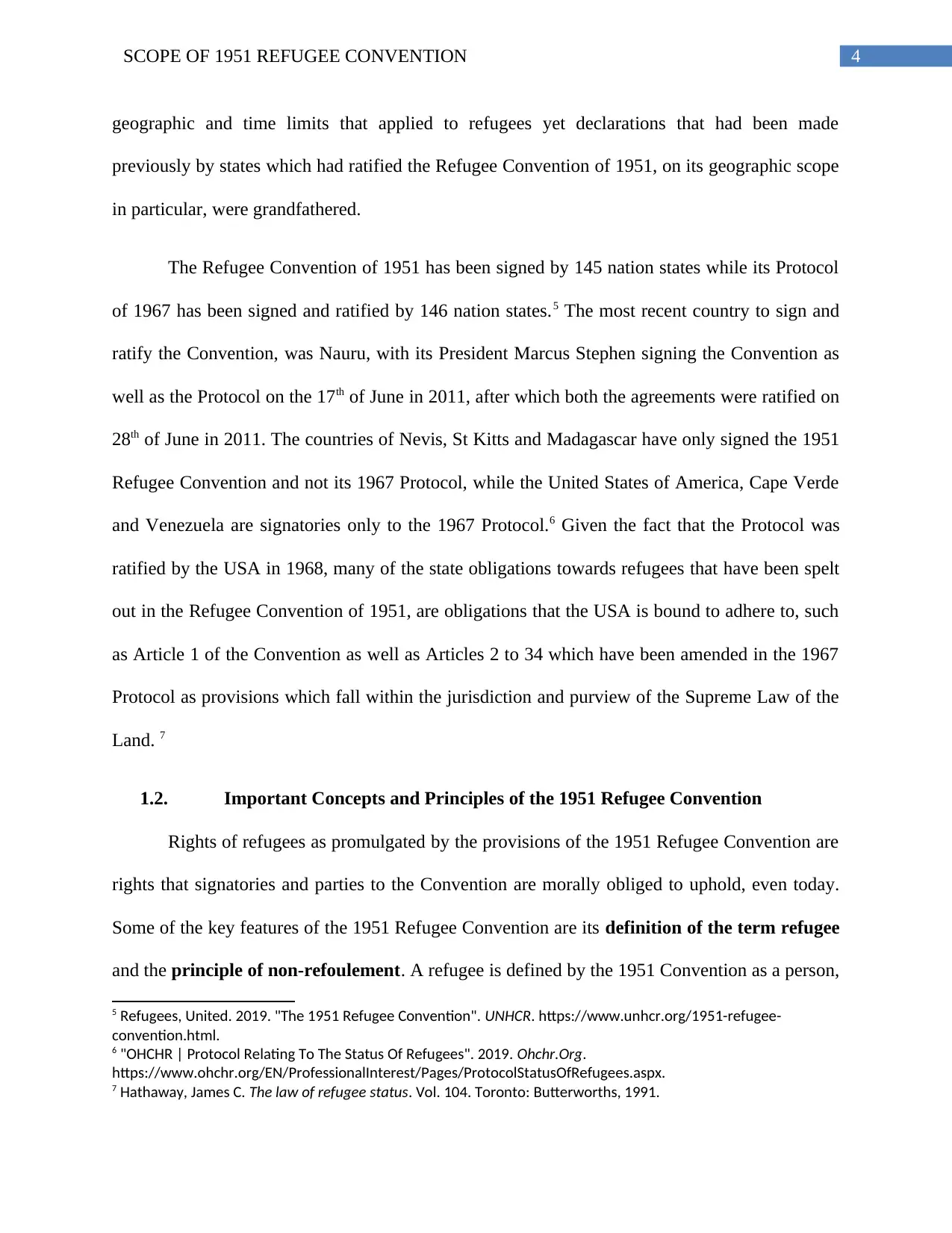
4SCOPE OF 1951 REFUGEE CONVENTION
geographic and time limits that applied to refugees yet declarations that had been made
previously by states which had ratified the Refugee Convention of 1951, on its geographic scope
in particular, were grandfathered.
The Refugee Convention of 1951 has been signed by 145 nation states while its Protocol
of 1967 has been signed and ratified by 146 nation states.5 The most recent country to sign and
ratify the Convention, was Nauru, with its President Marcus Stephen signing the Convention as
well as the Protocol on the 17th of June in 2011, after which both the agreements were ratified on
28th of June in 2011. The countries of Nevis, St Kitts and Madagascar have only signed the 1951
Refugee Convention and not its 1967 Protocol, while the United States of America, Cape Verde
and Venezuela are signatories only to the 1967 Protocol.6 Given the fact that the Protocol was
ratified by the USA in 1968, many of the state obligations towards refugees that have been spelt
out in the Refugee Convention of 1951, are obligations that the USA is bound to adhere to, such
as Article 1 of the Convention as well as Articles 2 to 34 which have been amended in the 1967
Protocol as provisions which fall within the jurisdiction and purview of the Supreme Law of the
Land. 7
1.2. Important Concepts and Principles of the 1951 Refugee Convention
Rights of refugees as promulgated by the provisions of the 1951 Refugee Convention are
rights that signatories and parties to the Convention are morally obliged to uphold, even today.
Some of the key features of the 1951 Refugee Convention are its definition of the term refugee
and the principle of non-refoulement. A refugee is defined by the 1951 Convention as a person,
5 Refugees, United. 2019. "The 1951 Refugee Convention". UNHCR. https://www.unhcr.org/1951-refugee-
convention.html.
6 "OHCHR | Protocol Relating To The Status Of Refugees". 2019. Ohchr.Org.
https://www.ohchr.org/EN/ProfessionalInterest/Pages/ProtocolStatusOfRefugees.aspx.
7 Hathaway, James C. The law of refugee status. Vol. 104. Toronto: Butterworths, 1991.
geographic and time limits that applied to refugees yet declarations that had been made
previously by states which had ratified the Refugee Convention of 1951, on its geographic scope
in particular, were grandfathered.
The Refugee Convention of 1951 has been signed by 145 nation states while its Protocol
of 1967 has been signed and ratified by 146 nation states.5 The most recent country to sign and
ratify the Convention, was Nauru, with its President Marcus Stephen signing the Convention as
well as the Protocol on the 17th of June in 2011, after which both the agreements were ratified on
28th of June in 2011. The countries of Nevis, St Kitts and Madagascar have only signed the 1951
Refugee Convention and not its 1967 Protocol, while the United States of America, Cape Verde
and Venezuela are signatories only to the 1967 Protocol.6 Given the fact that the Protocol was
ratified by the USA in 1968, many of the state obligations towards refugees that have been spelt
out in the Refugee Convention of 1951, are obligations that the USA is bound to adhere to, such
as Article 1 of the Convention as well as Articles 2 to 34 which have been amended in the 1967
Protocol as provisions which fall within the jurisdiction and purview of the Supreme Law of the
Land. 7
1.2. Important Concepts and Principles of the 1951 Refugee Convention
Rights of refugees as promulgated by the provisions of the 1951 Refugee Convention are
rights that signatories and parties to the Convention are morally obliged to uphold, even today.
Some of the key features of the 1951 Refugee Convention are its definition of the term refugee
and the principle of non-refoulement. A refugee is defined by the 1951 Convention as a person,
5 Refugees, United. 2019. "The 1951 Refugee Convention". UNHCR. https://www.unhcr.org/1951-refugee-
convention.html.
6 "OHCHR | Protocol Relating To The Status Of Refugees". 2019. Ohchr.Org.
https://www.ohchr.org/EN/ProfessionalInterest/Pages/ProtocolStatusOfRefugees.aspx.
7 Hathaway, James C. The law of refugee status. Vol. 104. Toronto: Butterworths, 1991.
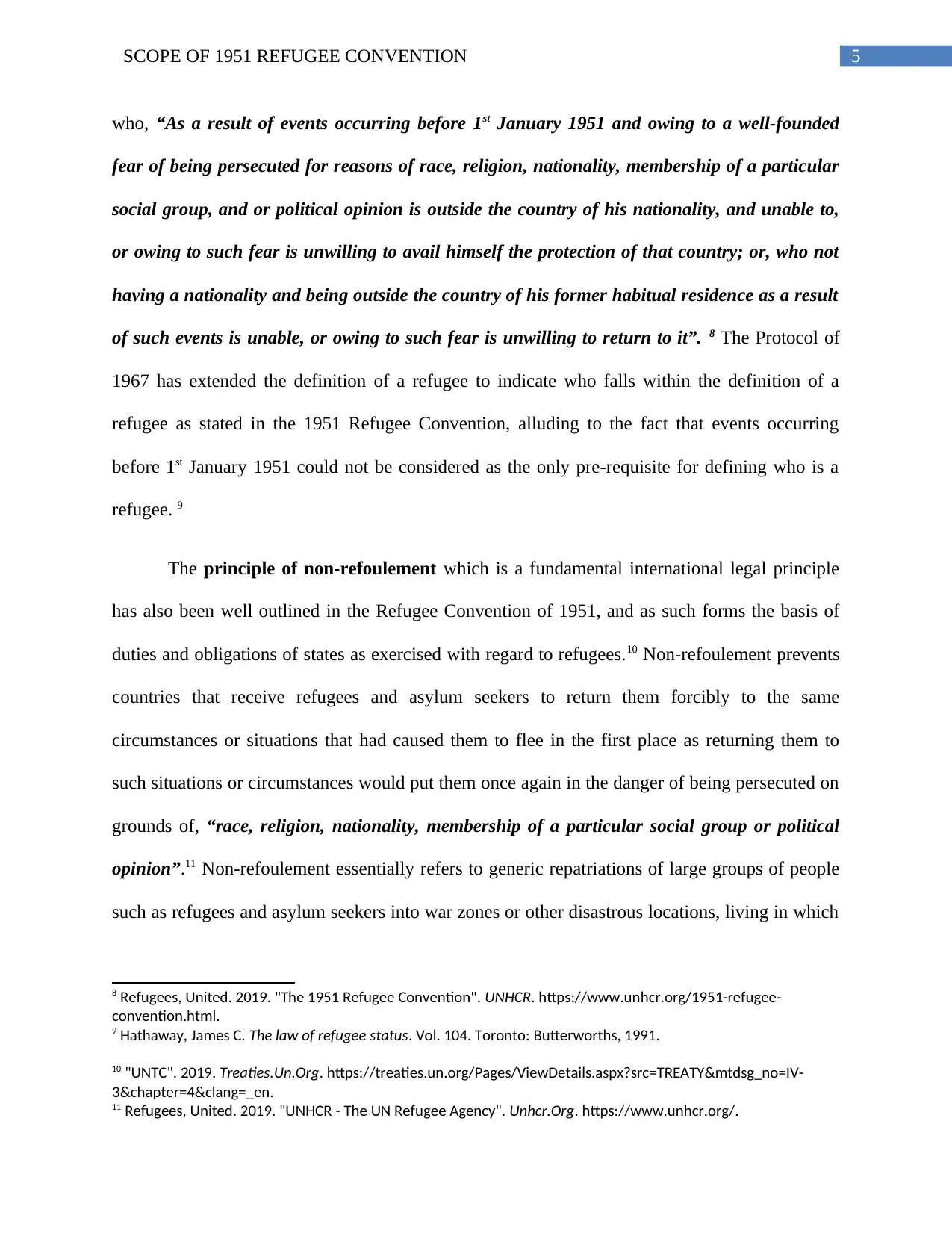
5SCOPE OF 1951 REFUGEE CONVENTION
who, “As a result of events occurring before 1st January 1951 and owing to a well-founded
fear of being persecuted for reasons of race, religion, nationality, membership of a particular
social group, and or political opinion is outside the country of his nationality, and unable to,
or owing to such fear is unwilling to avail himself the protection of that country; or, who not
having a nationality and being outside the country of his former habitual residence as a result
of such events is unable, or owing to such fear is unwilling to return to it”. 8 The Protocol of
1967 has extended the definition of a refugee to indicate who falls within the definition of a
refugee as stated in the 1951 Refugee Convention, alluding to the fact that events occurring
before 1st January 1951 could not be considered as the only pre-requisite for defining who is a
refugee. 9
The principle of non-refoulement which is a fundamental international legal principle
has also been well outlined in the Refugee Convention of 1951, and as such forms the basis of
duties and obligations of states as exercised with regard to refugees.10 Non-refoulement prevents
countries that receive refugees and asylum seekers to return them forcibly to the same
circumstances or situations that had caused them to flee in the first place as returning them to
such situations or circumstances would put them once again in the danger of being persecuted on
grounds of, “race, religion, nationality, membership of a particular social group or political
opinion”.11 Non-refoulement essentially refers to generic repatriations of large groups of people
such as refugees and asylum seekers into war zones or other disastrous locations, living in which
8 Refugees, United. 2019. "The 1951 Refugee Convention". UNHCR. https://www.unhcr.org/1951-refugee-
convention.html.
9 Hathaway, James C. The law of refugee status. Vol. 104. Toronto: Butterworths, 1991.
10 "UNTC". 2019. Treaties.Un.Org. https://treaties.un.org/Pages/ViewDetails.aspx?src=TREATY&mtdsg_no=IV-
3&chapter=4&clang=_en.
11 Refugees, United. 2019. "UNHCR - The UN Refugee Agency". Unhcr.Org. https://www.unhcr.org/.
who, “As a result of events occurring before 1st January 1951 and owing to a well-founded
fear of being persecuted for reasons of race, religion, nationality, membership of a particular
social group, and or political opinion is outside the country of his nationality, and unable to,
or owing to such fear is unwilling to avail himself the protection of that country; or, who not
having a nationality and being outside the country of his former habitual residence as a result
of such events is unable, or owing to such fear is unwilling to return to it”. 8 The Protocol of
1967 has extended the definition of a refugee to indicate who falls within the definition of a
refugee as stated in the 1951 Refugee Convention, alluding to the fact that events occurring
before 1st January 1951 could not be considered as the only pre-requisite for defining who is a
refugee. 9
The principle of non-refoulement which is a fundamental international legal principle
has also been well outlined in the Refugee Convention of 1951, and as such forms the basis of
duties and obligations of states as exercised with regard to refugees.10 Non-refoulement prevents
countries that receive refugees and asylum seekers to return them forcibly to the same
circumstances or situations that had caused them to flee in the first place as returning them to
such situations or circumstances would put them once again in the danger of being persecuted on
grounds of, “race, religion, nationality, membership of a particular social group or political
opinion”.11 Non-refoulement essentially refers to generic repatriations of large groups of people
such as refugees and asylum seekers into war zones or other disastrous locations, living in which
8 Refugees, United. 2019. "The 1951 Refugee Convention". UNHCR. https://www.unhcr.org/1951-refugee-
convention.html.
9 Hathaway, James C. The law of refugee status. Vol. 104. Toronto: Butterworths, 1991.
10 "UNTC". 2019. Treaties.Un.Org. https://treaties.un.org/Pages/ViewDetails.aspx?src=TREATY&mtdsg_no=IV-
3&chapter=4&clang=_en.
11 Refugees, United. 2019. "UNHCR - The UN Refugee Agency". Unhcr.Org. https://www.unhcr.org/.
⊘ This is a preview!⊘
Do you want full access?
Subscribe today to unlock all pages.

Trusted by 1+ million students worldwide
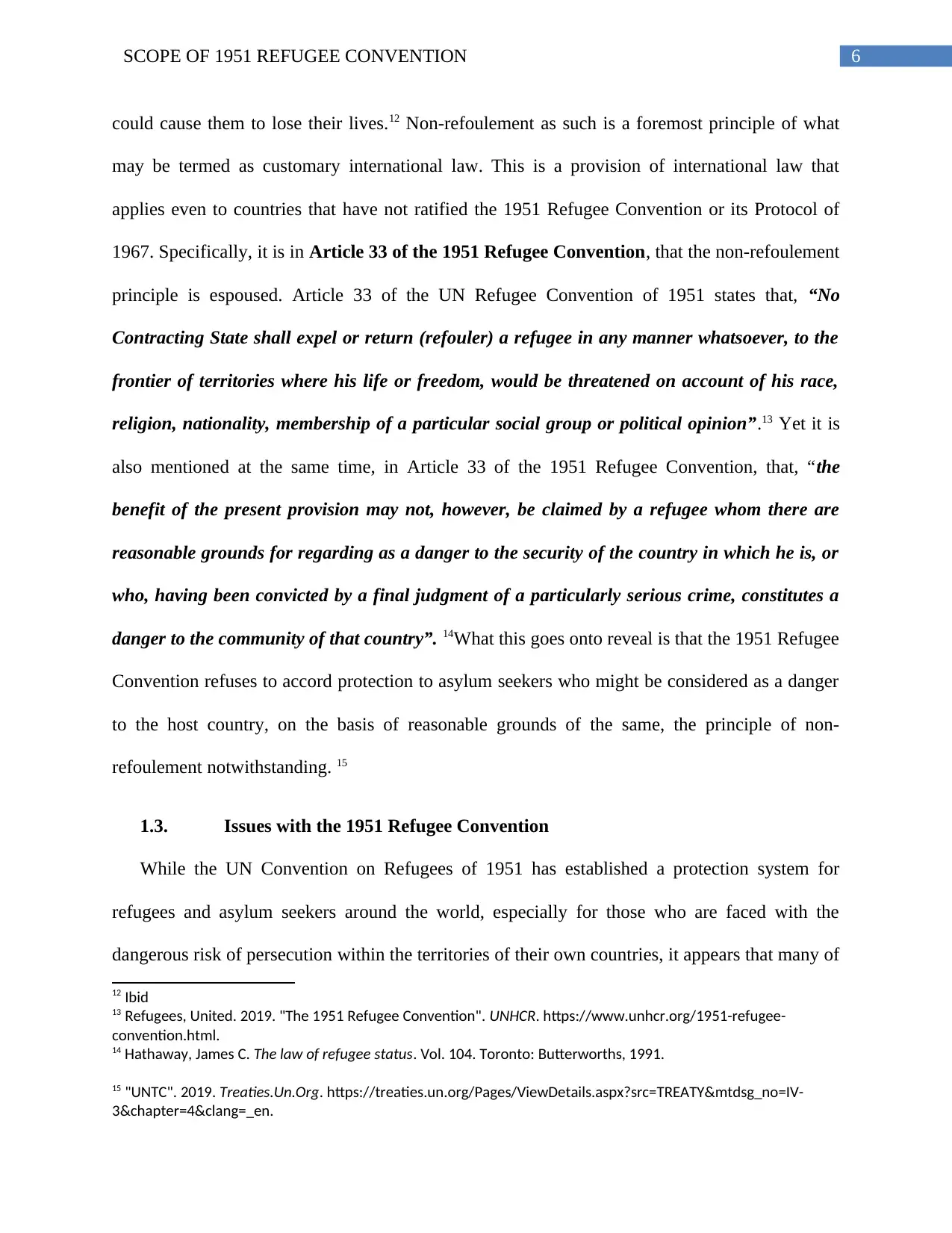
6SCOPE OF 1951 REFUGEE CONVENTION
could cause them to lose their lives.12 Non-refoulement as such is a foremost principle of what
may be termed as customary international law. This is a provision of international law that
applies even to countries that have not ratified the 1951 Refugee Convention or its Protocol of
1967. Specifically, it is in Article 33 of the 1951 Refugee Convention, that the non-refoulement
principle is espoused. Article 33 of the UN Refugee Convention of 1951 states that, “No
Contracting State shall expel or return (refouler) a refugee in any manner whatsoever, to the
frontier of territories where his life or freedom, would be threatened on account of his race,
religion, nationality, membership of a particular social group or political opinion”.13 Yet it is
also mentioned at the same time, in Article 33 of the 1951 Refugee Convention, that, “the
benefit of the present provision may not, however, be claimed by a refugee whom there are
reasonable grounds for regarding as a danger to the security of the country in which he is, or
who, having been convicted by a final judgment of a particularly serious crime, constitutes a
danger to the community of that country”. 14What this goes onto reveal is that the 1951 Refugee
Convention refuses to accord protection to asylum seekers who might be considered as a danger
to the host country, on the basis of reasonable grounds of the same, the principle of non-
refoulement notwithstanding. 15
1.3. Issues with the 1951 Refugee Convention
While the UN Convention on Refugees of 1951 has established a protection system for
refugees and asylum seekers around the world, especially for those who are faced with the
dangerous risk of persecution within the territories of their own countries, it appears that many of
12 Ibid
13 Refugees, United. 2019. "The 1951 Refugee Convention". UNHCR. https://www.unhcr.org/1951-refugee-
convention.html.
14 Hathaway, James C. The law of refugee status. Vol. 104. Toronto: Butterworths, 1991.
15 "UNTC". 2019. Treaties.Un.Org. https://treaties.un.org/Pages/ViewDetails.aspx?src=TREATY&mtdsg_no=IV-
3&chapter=4&clang=_en.
could cause them to lose their lives.12 Non-refoulement as such is a foremost principle of what
may be termed as customary international law. This is a provision of international law that
applies even to countries that have not ratified the 1951 Refugee Convention or its Protocol of
1967. Specifically, it is in Article 33 of the 1951 Refugee Convention, that the non-refoulement
principle is espoused. Article 33 of the UN Refugee Convention of 1951 states that, “No
Contracting State shall expel or return (refouler) a refugee in any manner whatsoever, to the
frontier of territories where his life or freedom, would be threatened on account of his race,
religion, nationality, membership of a particular social group or political opinion”.13 Yet it is
also mentioned at the same time, in Article 33 of the 1951 Refugee Convention, that, “the
benefit of the present provision may not, however, be claimed by a refugee whom there are
reasonable grounds for regarding as a danger to the security of the country in which he is, or
who, having been convicted by a final judgment of a particularly serious crime, constitutes a
danger to the community of that country”. 14What this goes onto reveal is that the 1951 Refugee
Convention refuses to accord protection to asylum seekers who might be considered as a danger
to the host country, on the basis of reasonable grounds of the same, the principle of non-
refoulement notwithstanding. 15
1.3. Issues with the 1951 Refugee Convention
While the UN Convention on Refugees of 1951 has established a protection system for
refugees and asylum seekers around the world, especially for those who are faced with the
dangerous risk of persecution within the territories of their own countries, it appears that many of
12 Ibid
13 Refugees, United. 2019. "The 1951 Refugee Convention". UNHCR. https://www.unhcr.org/1951-refugee-
convention.html.
14 Hathaway, James C. The law of refugee status. Vol. 104. Toronto: Butterworths, 1991.
15 "UNTC". 2019. Treaties.Un.Org. https://treaties.un.org/Pages/ViewDetails.aspx?src=TREATY&mtdsg_no=IV-
3&chapter=4&clang=_en.
Paraphrase This Document
Need a fresh take? Get an instant paraphrase of this document with our AI Paraphraser
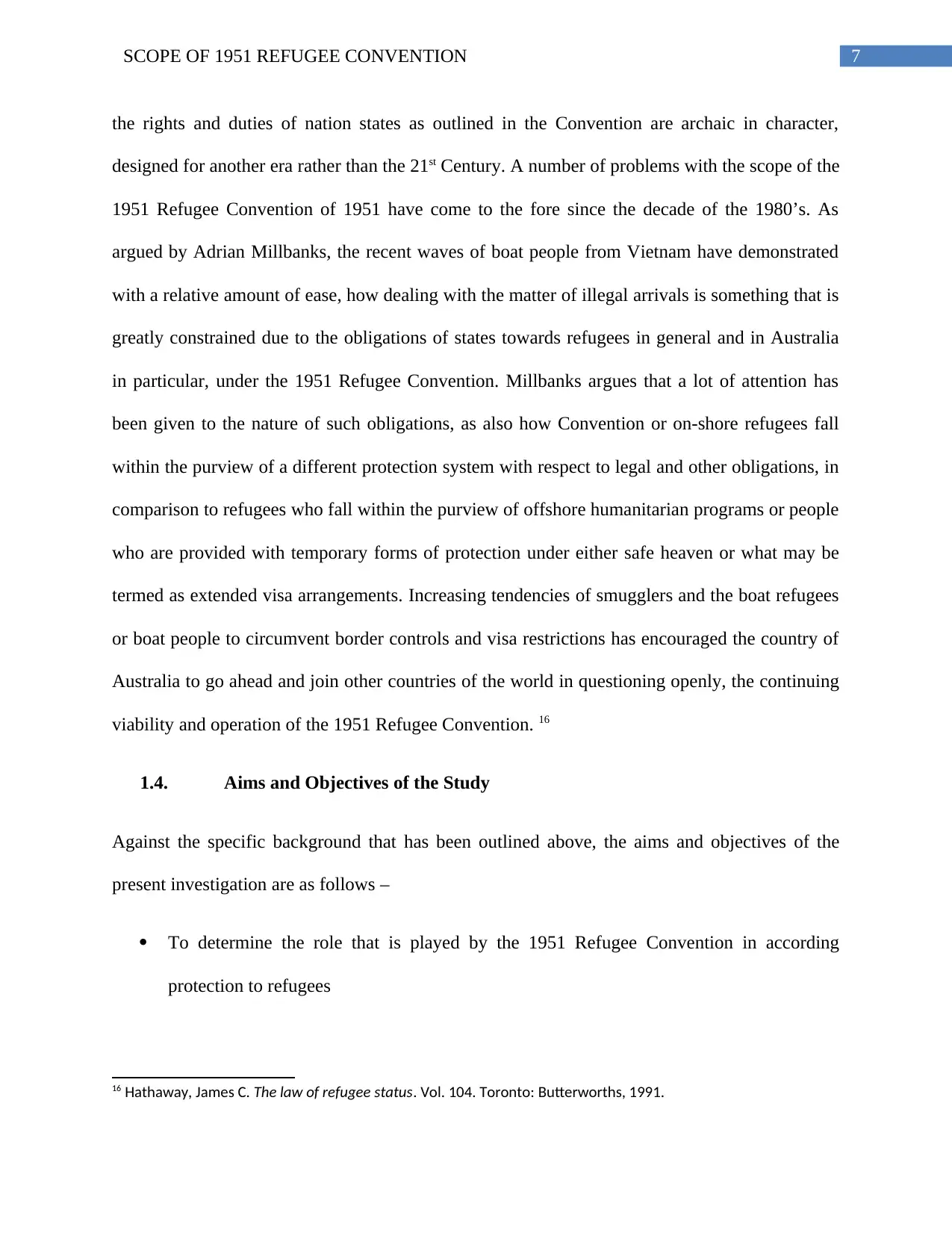
7SCOPE OF 1951 REFUGEE CONVENTION
the rights and duties of nation states as outlined in the Convention are archaic in character,
designed for another era rather than the 21st Century. A number of problems with the scope of the
1951 Refugee Convention of 1951 have come to the fore since the decade of the 1980’s. As
argued by Adrian Millbanks, the recent waves of boat people from Vietnam have demonstrated
with a relative amount of ease, how dealing with the matter of illegal arrivals is something that is
greatly constrained due to the obligations of states towards refugees in general and in Australia
in particular, under the 1951 Refugee Convention. Millbanks argues that a lot of attention has
been given to the nature of such obligations, as also how Convention or on-shore refugees fall
within the purview of a different protection system with respect to legal and other obligations, in
comparison to refugees who fall within the purview of offshore humanitarian programs or people
who are provided with temporary forms of protection under either safe heaven or what may be
termed as extended visa arrangements. Increasing tendencies of smugglers and the boat refugees
or boat people to circumvent border controls and visa restrictions has encouraged the country of
Australia to go ahead and join other countries of the world in questioning openly, the continuing
viability and operation of the 1951 Refugee Convention. 16
1.4. Aims and Objectives of the Study
Against the specific background that has been outlined above, the aims and objectives of the
present investigation are as follows –
To determine the role that is played by the 1951 Refugee Convention in according
protection to refugees
16 Hathaway, James C. The law of refugee status. Vol. 104. Toronto: Butterworths, 1991.
the rights and duties of nation states as outlined in the Convention are archaic in character,
designed for another era rather than the 21st Century. A number of problems with the scope of the
1951 Refugee Convention of 1951 have come to the fore since the decade of the 1980’s. As
argued by Adrian Millbanks, the recent waves of boat people from Vietnam have demonstrated
with a relative amount of ease, how dealing with the matter of illegal arrivals is something that is
greatly constrained due to the obligations of states towards refugees in general and in Australia
in particular, under the 1951 Refugee Convention. Millbanks argues that a lot of attention has
been given to the nature of such obligations, as also how Convention or on-shore refugees fall
within the purview of a different protection system with respect to legal and other obligations, in
comparison to refugees who fall within the purview of offshore humanitarian programs or people
who are provided with temporary forms of protection under either safe heaven or what may be
termed as extended visa arrangements. Increasing tendencies of smugglers and the boat refugees
or boat people to circumvent border controls and visa restrictions has encouraged the country of
Australia to go ahead and join other countries of the world in questioning openly, the continuing
viability and operation of the 1951 Refugee Convention. 16
1.4. Aims and Objectives of the Study
Against the specific background that has been outlined above, the aims and objectives of the
present investigation are as follows –
To determine the role that is played by the 1951 Refugee Convention in according
protection to refugees
16 Hathaway, James C. The law of refugee status. Vol. 104. Toronto: Butterworths, 1991.
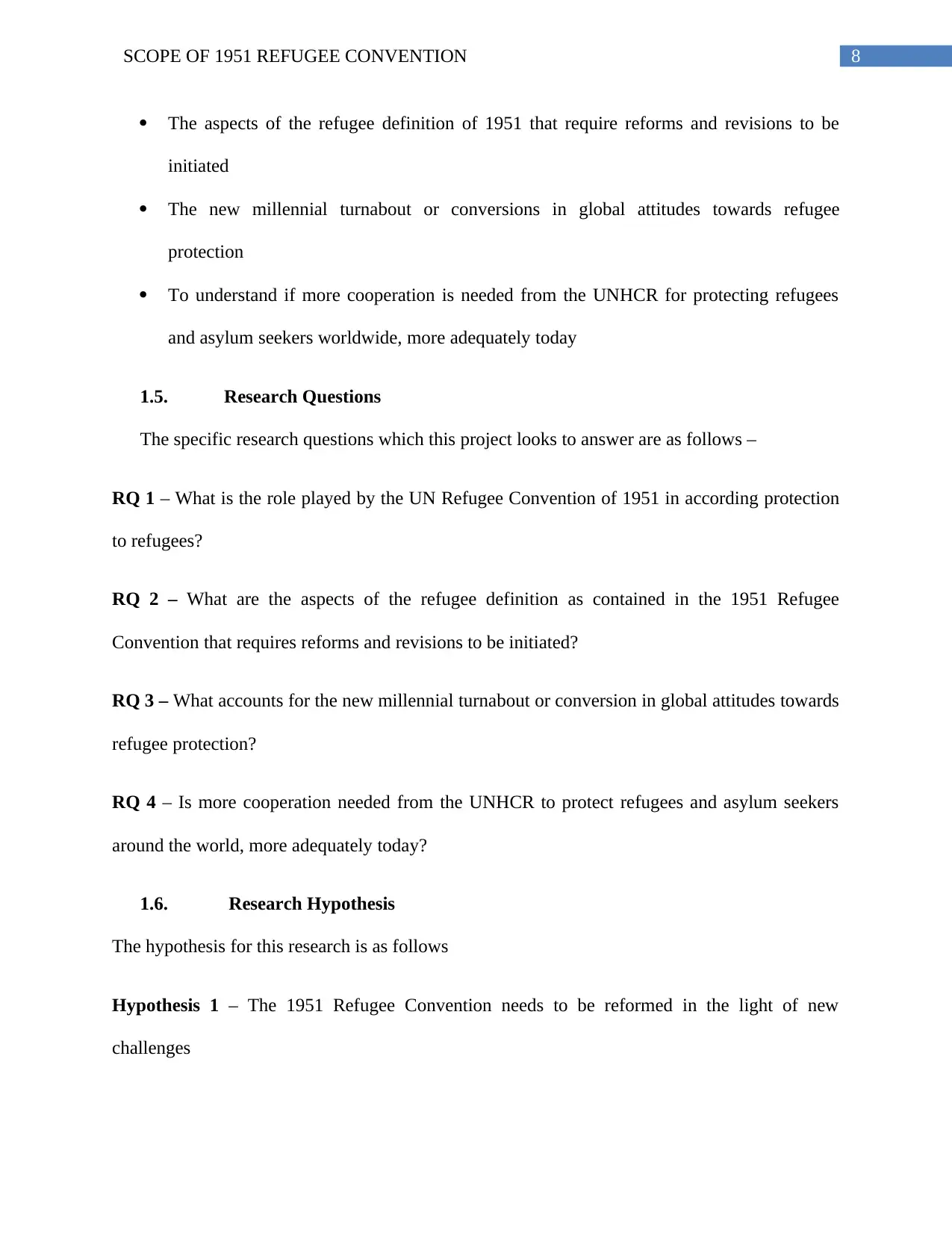
8SCOPE OF 1951 REFUGEE CONVENTION
The aspects of the refugee definition of 1951 that require reforms and revisions to be
initiated
The new millennial turnabout or conversions in global attitudes towards refugee
protection
To understand if more cooperation is needed from the UNHCR for protecting refugees
and asylum seekers worldwide, more adequately today
1.5. Research Questions
The specific research questions which this project looks to answer are as follows –
RQ 1 – What is the role played by the UN Refugee Convention of 1951 in according protection
to refugees?
RQ 2 – What are the aspects of the refugee definition as contained in the 1951 Refugee
Convention that requires reforms and revisions to be initiated?
RQ 3 – What accounts for the new millennial turnabout or conversion in global attitudes towards
refugee protection?
RQ 4 – Is more cooperation needed from the UNHCR to protect refugees and asylum seekers
around the world, more adequately today?
1.6. Research Hypothesis
The hypothesis for this research is as follows
Hypothesis 1 – The 1951 Refugee Convention needs to be reformed in the light of new
challenges
The aspects of the refugee definition of 1951 that require reforms and revisions to be
initiated
The new millennial turnabout or conversions in global attitudes towards refugee
protection
To understand if more cooperation is needed from the UNHCR for protecting refugees
and asylum seekers worldwide, more adequately today
1.5. Research Questions
The specific research questions which this project looks to answer are as follows –
RQ 1 – What is the role played by the UN Refugee Convention of 1951 in according protection
to refugees?
RQ 2 – What are the aspects of the refugee definition as contained in the 1951 Refugee
Convention that requires reforms and revisions to be initiated?
RQ 3 – What accounts for the new millennial turnabout or conversion in global attitudes towards
refugee protection?
RQ 4 – Is more cooperation needed from the UNHCR to protect refugees and asylum seekers
around the world, more adequately today?
1.6. Research Hypothesis
The hypothesis for this research is as follows
Hypothesis 1 – The 1951 Refugee Convention needs to be reformed in the light of new
challenges
⊘ This is a preview!⊘
Do you want full access?
Subscribe today to unlock all pages.

Trusted by 1+ million students worldwide
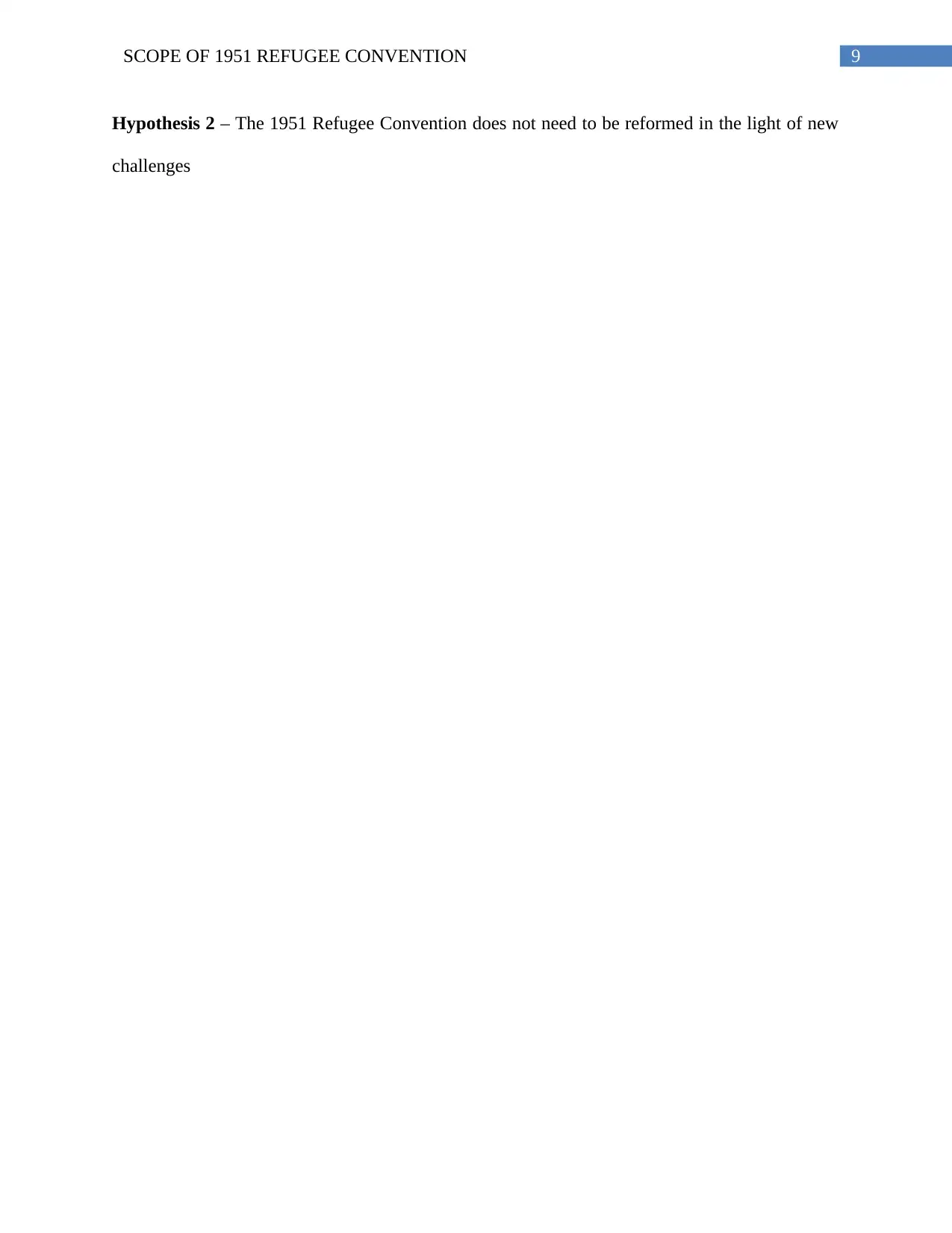
9SCOPE OF 1951 REFUGEE CONVENTION
Hypothesis 2 – The 1951 Refugee Convention does not need to be reformed in the light of new
challenges
Hypothesis 2 – The 1951 Refugee Convention does not need to be reformed in the light of new
challenges
Paraphrase This Document
Need a fresh take? Get an instant paraphrase of this document with our AI Paraphraser
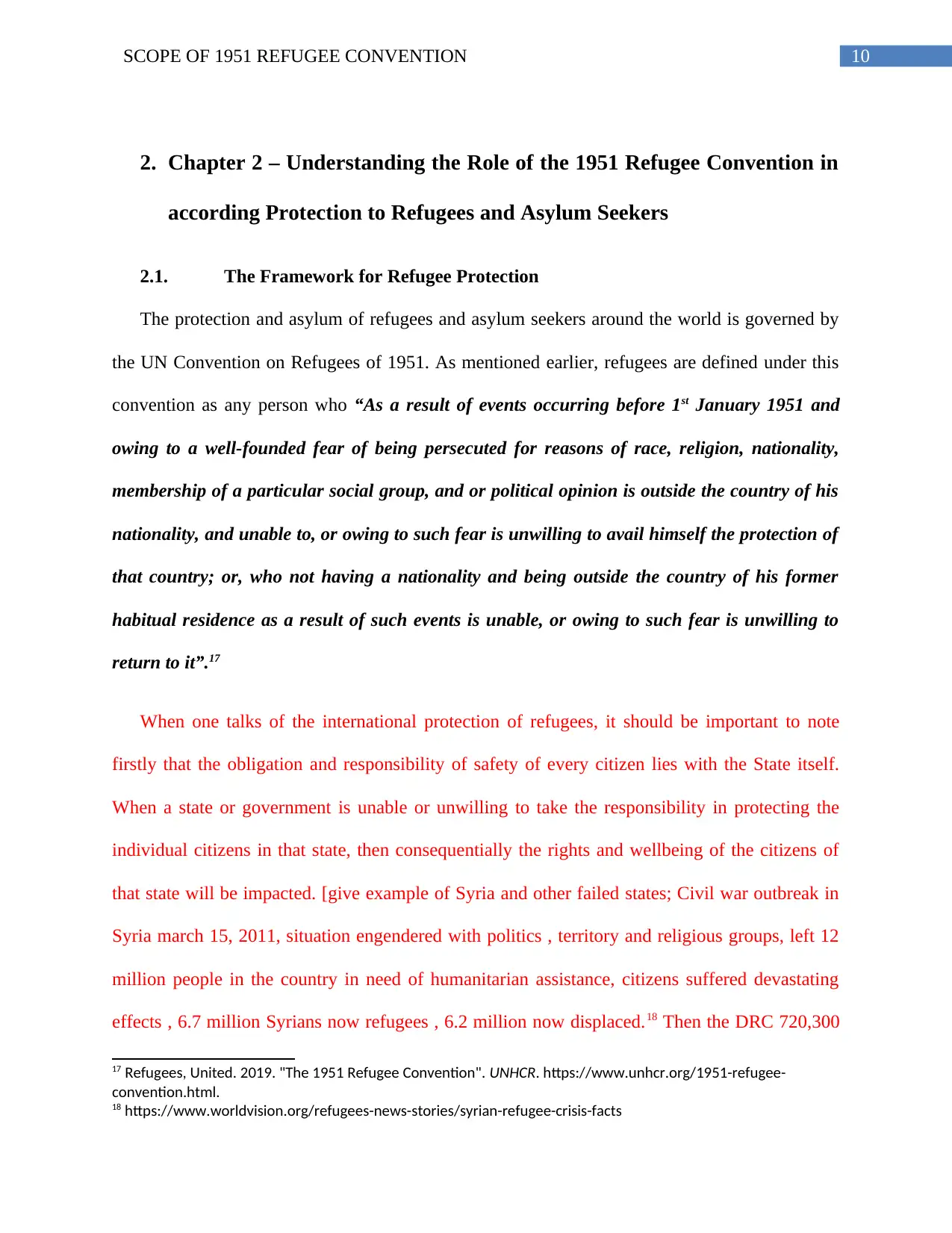
10SCOPE OF 1951 REFUGEE CONVENTION
2. Chapter 2 – Understanding the Role of the 1951 Refugee Convention in
according Protection to Refugees and Asylum Seekers
2.1. The Framework for Refugee Protection
The protection and asylum of refugees and asylum seekers around the world is governed by
the UN Convention on Refugees of 1951. As mentioned earlier, refugees are defined under this
convention as any person who “As a result of events occurring before 1st January 1951 and
owing to a well-founded fear of being persecuted for reasons of race, religion, nationality,
membership of a particular social group, and or political opinion is outside the country of his
nationality, and unable to, or owing to such fear is unwilling to avail himself the protection of
that country; or, who not having a nationality and being outside the country of his former
habitual residence as a result of such events is unable, or owing to such fear is unwilling to
return to it”.17
When one talks of the international protection of refugees, it should be important to note
firstly that the obligation and responsibility of safety of every citizen lies with the State itself.
When a state or government is unable or unwilling to take the responsibility in protecting the
individual citizens in that state, then consequentially the rights and wellbeing of the citizens of
that state will be impacted. [give example of Syria and other failed states; Civil war outbreak in
Syria march 15, 2011, situation engendered with politics , territory and religious groups, left 12
million people in the country in need of humanitarian assistance, citizens suffered devastating
effects , 6.7 million Syrians now refugees , 6.2 million now displaced.18 Then the DRC 720,300
17 Refugees, United. 2019. "The 1951 Refugee Convention". UNHCR. https://www.unhcr.org/1951-refugee-
convention.html.
18 https://www.worldvision.org/refugees-news-stories/syrian-refugee-crisis-facts
2. Chapter 2 – Understanding the Role of the 1951 Refugee Convention in
according Protection to Refugees and Asylum Seekers
2.1. The Framework for Refugee Protection
The protection and asylum of refugees and asylum seekers around the world is governed by
the UN Convention on Refugees of 1951. As mentioned earlier, refugees are defined under this
convention as any person who “As a result of events occurring before 1st January 1951 and
owing to a well-founded fear of being persecuted for reasons of race, religion, nationality,
membership of a particular social group, and or political opinion is outside the country of his
nationality, and unable to, or owing to such fear is unwilling to avail himself the protection of
that country; or, who not having a nationality and being outside the country of his former
habitual residence as a result of such events is unable, or owing to such fear is unwilling to
return to it”.17
When one talks of the international protection of refugees, it should be important to note
firstly that the obligation and responsibility of safety of every citizen lies with the State itself.
When a state or government is unable or unwilling to take the responsibility in protecting the
individual citizens in that state, then consequentially the rights and wellbeing of the citizens of
that state will be impacted. [give example of Syria and other failed states; Civil war outbreak in
Syria march 15, 2011, situation engendered with politics , territory and religious groups, left 12
million people in the country in need of humanitarian assistance, citizens suffered devastating
effects , 6.7 million Syrians now refugees , 6.2 million now displaced.18 Then the DRC 720,300
17 Refugees, United. 2019. "The 1951 Refugee Convention". UNHCR. https://www.unhcr.org/1951-refugee-
convention.html.
18 https://www.worldvision.org/refugees-news-stories/syrian-refugee-crisis-facts
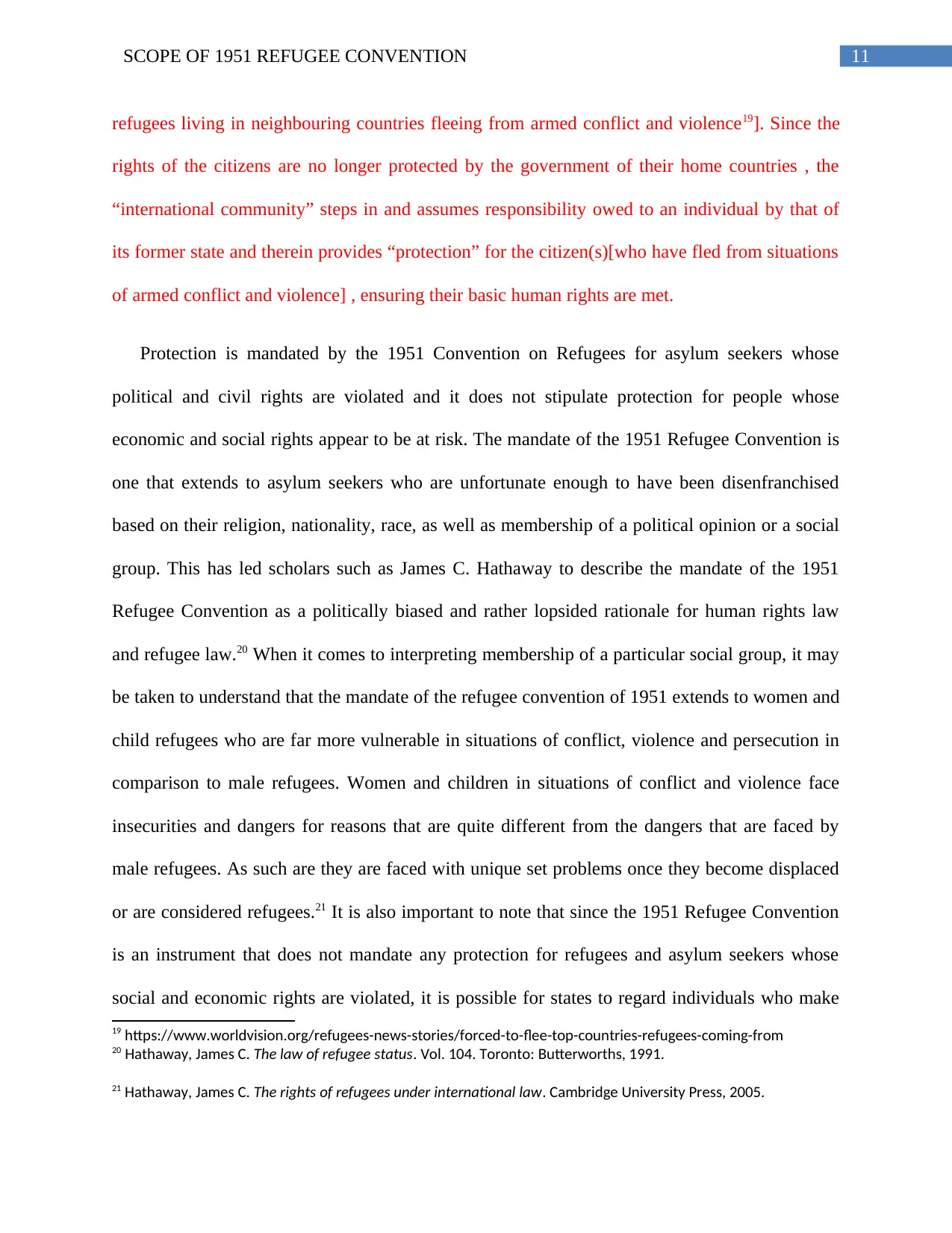
11SCOPE OF 1951 REFUGEE CONVENTION
refugees living in neighbouring countries fleeing from armed conflict and violence19]. Since the
rights of the citizens are no longer protected by the government of their home countries , the
“international community” steps in and assumes responsibility owed to an individual by that of
its former state and therein provides “protection” for the citizen(s)[who have fled from situations
of armed conflict and violence] , ensuring their basic human rights are met.
Protection is mandated by the 1951 Convention on Refugees for asylum seekers whose
political and civil rights are violated and it does not stipulate protection for people whose
economic and social rights appear to be at risk. The mandate of the 1951 Refugee Convention is
one that extends to asylum seekers who are unfortunate enough to have been disenfranchised
based on their religion, nationality, race, as well as membership of a political opinion or a social
group. This has led scholars such as James C. Hathaway to describe the mandate of the 1951
Refugee Convention as a politically biased and rather lopsided rationale for human rights law
and refugee law.20 When it comes to interpreting membership of a particular social group, it may
be taken to understand that the mandate of the refugee convention of 1951 extends to women and
child refugees who are far more vulnerable in situations of conflict, violence and persecution in
comparison to male refugees. Women and children in situations of conflict and violence face
insecurities and dangers for reasons that are quite different from the dangers that are faced by
male refugees. As such are they are faced with unique set problems once they become displaced
or are considered refugees.21 It is also important to note that since the 1951 Refugee Convention
is an instrument that does not mandate any protection for refugees and asylum seekers whose
social and economic rights are violated, it is possible for states to regard individuals who make
19 https://www.worldvision.org/refugees-news-stories/forced-to-flee-top-countries-refugees-coming-from
20 Hathaway, James C. The law of refugee status. Vol. 104. Toronto: Butterworths, 1991.
21 Hathaway, James C. The rights of refugees under international law. Cambridge University Press, 2005.
refugees living in neighbouring countries fleeing from armed conflict and violence19]. Since the
rights of the citizens are no longer protected by the government of their home countries , the
“international community” steps in and assumes responsibility owed to an individual by that of
its former state and therein provides “protection” for the citizen(s)[who have fled from situations
of armed conflict and violence] , ensuring their basic human rights are met.
Protection is mandated by the 1951 Convention on Refugees for asylum seekers whose
political and civil rights are violated and it does not stipulate protection for people whose
economic and social rights appear to be at risk. The mandate of the 1951 Refugee Convention is
one that extends to asylum seekers who are unfortunate enough to have been disenfranchised
based on their religion, nationality, race, as well as membership of a political opinion or a social
group. This has led scholars such as James C. Hathaway to describe the mandate of the 1951
Refugee Convention as a politically biased and rather lopsided rationale for human rights law
and refugee law.20 When it comes to interpreting membership of a particular social group, it may
be taken to understand that the mandate of the refugee convention of 1951 extends to women and
child refugees who are far more vulnerable in situations of conflict, violence and persecution in
comparison to male refugees. Women and children in situations of conflict and violence face
insecurities and dangers for reasons that are quite different from the dangers that are faced by
male refugees. As such are they are faced with unique set problems once they become displaced
or are considered refugees.21 It is also important to note that since the 1951 Refugee Convention
is an instrument that does not mandate any protection for refugees and asylum seekers whose
social and economic rights are violated, it is possible for states to regard individuals who make
19 https://www.worldvision.org/refugees-news-stories/forced-to-flee-top-countries-refugees-coming-from
20 Hathaway, James C. The law of refugee status. Vol. 104. Toronto: Butterworths, 1991.
21 Hathaway, James C. The rights of refugees under international law. Cambridge University Press, 2005.
⊘ This is a preview!⊘
Do you want full access?
Subscribe today to unlock all pages.

Trusted by 1+ million students worldwide
1 out of 72
Your All-in-One AI-Powered Toolkit for Academic Success.
+13062052269
info@desklib.com
Available 24*7 on WhatsApp / Email
![[object Object]](/_next/static/media/star-bottom.7253800d.svg)
Unlock your academic potential
Copyright © 2020–2025 A2Z Services. All Rights Reserved. Developed and managed by ZUCOL.


